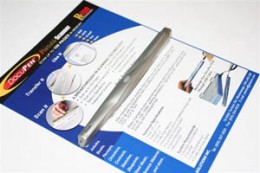DOCUPEN R700
Overview
Reviews: AccessoriesPros:
Small, portable scanner with rechargeable battery.Cons:
Difficult to master correct scanning position.A portable scanner in action. Is it worth the price? Does it realy work? Find out more in our full review.
The DocuPen R700 is a battery operated portable and easy to use scanner that can be used anywhere to capture up to 100 pages into its memory.
We tested the R700 comes with an internal Lithium Ion battery. This scanner is slightly bigger than a large pen (8.5″x 0.5″) and has its own carry case and weighs only 2 ounces. The package comes with a USB cable so you can sync scanned documents with your PC, using ScanSoft PaperPort 8.0.
The software installation was simple keeping in mind that we had to install the software before connecting the device to the PC’s USB port.
The scanner has four LEDs that indicate the state of its memory, state of the batteries and whether you are dragging the scanner too fast down the page.
To scan a page, the start button on the DocuPen is pressed, after which you have three seconds to start the scan. The button is fairly stiff so it took us a while before we learnt how to do it correctly. One click and the system will go into the standard 100 DPI mode, and with two clicks of the button, the system will go into the 200 DPI mode. Each indicated by the LEDs, which also show when the scanner is on. As soon as you start scanning, the scanner lens lights up, indicating the scan in progress.
We tested the product using different sheets of printed paper, with some color text and photos by laying them flat on the table. We then positioned the DocuPen scanner across the top of the paper. While holding the top of the sheet with one hand, we started to roll the scanner down the page holding it with the other hand, pressing on the rollers to ensure the scanner is at a correct level from the top of the paper. These rollers are located under the scanner that assists you during the scanning process. The Operating Manual suggests that a regular page at 100 DPI should take between 4 to 6 seconds to scan. We initially did go much faster causing the red LED to blink – that means some of the scan may not have been processed. Once the scan is completed correctly, it takes a few seconds for the scanner to process the data, indicated by flickering green LEDs. The scanning had to be slower than the 4 second. Even if you go too fast and the red LED blinks, the data scanned is captured and saved in a file, so you have to manually delete it later. The process was quick, but we could not see the results yet.
Our next task was to download the scanned data from the internal 2MB flash memory of the scanner to the computer. We connected the scanner to the USB port of the test system. The PaperPort software allowed us to download, after a few tries to understand what to do, our scanned page from the scanner memory to the hard disk. We also tested the OCR, by dragging the document, in PaperPort, to the Microsoft Word icon. The PaperPort program converts the scanned image into text. In the page we had scanned it had difficulty with some fonts and words, but this was not worse than other OCR. PaperPort is included in the package. The OCR processed the file quickly and was fairly good at converting the image to text, even in areas where the scanner had skewed across the page.
The scanner has two scanning resolutions, 100 DPI and 200 DPI. With the lower resolution, the memory has a capacity to hold 100 pages. With the higher resolution, up to 50 pages can be stored in memory. For normal use, we think this should be enough capacity. In any case, the battery only lasts for 100 scanned pages. The battery charges through the USB connection.
The DocuPen memory will hold all scanned images until they are deleted manually from within PaperPort. While this can be considered a safety precaution, we would prefer if the package would automatically removed the imported scanned documents from the scanner memory.
An important limitation to note is the width of the scanner which is only 8.5 inches. This barely covers the regular letter size paper width (European A4 size paper is narrower and more suited to this scanner). If you are trying to scan a larger magazine, book or newspaper you’ll need to do 2 passes of scan in order to get the whole page.
Our biggest complaint is the learning curve in properly dragging the scanner down the page while keeping it straight. Throughout our test runs we often found our testers pulling one side down faster than the other side, particularly towards the end of the scan.
In a flatbed scanner, the scanning process is automatic with constant speed of the lens, and there is little chance of getting skewed scans. Also, the flatbed scanners save the scanned images directly into the memory of the attached computer. However, with all its faults, the DocuPen is portable and has a good size memory.
Overall this is a good gadget to have around. Its small size and weight combined with its capacity to store 100 scanned pages with one battery charge make this scanner a time saver for those who are out of their office, for example real estate agents, lawyers, construction engineers, mortgage brokers etc.


